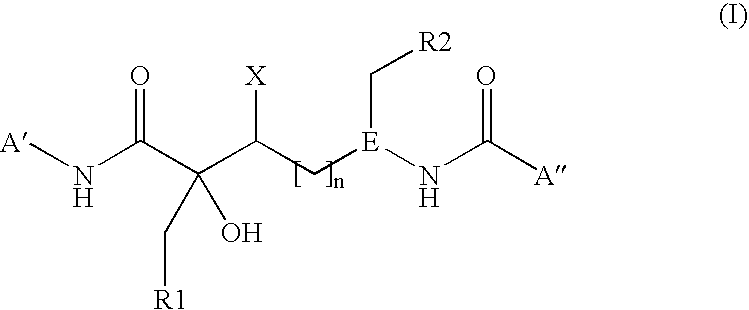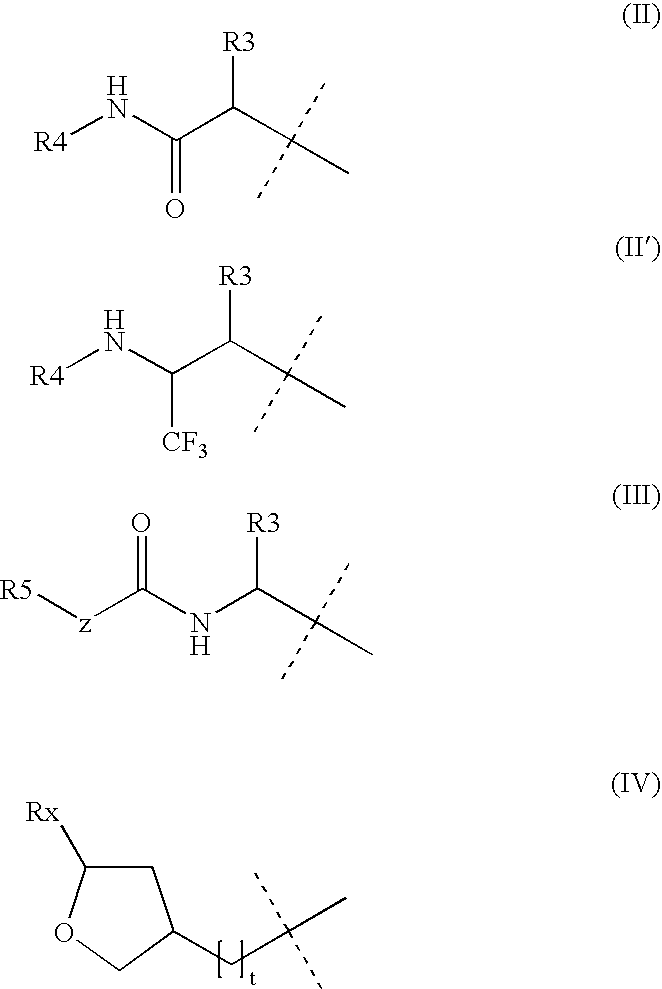HIV protease inhibitors
a technology of protease inhibitors and hives, which is applied in the field of hive protease inhibitors, can solve the problems of reducing the effectiveness of the immune system, debilitating and ultimately fatal opportunistic infections, and changing the glycoproteins on the surface of the viral protective coa
- Summary
- Abstract
- Description
- Claims
- Application Information
AI Technical Summary
Benefits of technology
Problems solved by technology
Method used
Image
Examples
example 1
[0272]
2-Benzyl-N-[(1S,2R)-2-hydroxy-indan-1-yl]-acryl amide (1)
[0273]2-Benzyl acrylic acid (J. Organomet., Chem. 646, 212-222, 2002) (2.72 g, 16.8 mmol) was dissolved in EtOAc (50 mL) and EDAC (3.54 g, 18.5 mmol), HOBT (2.49 g, 18.4 mmol) and NMM (2.21 mL, 20.1 mmol) were added. The reaction mixture was stirred at room temperature for 30 min and then (1S,2R)-1-amino-2-indanol (2.75 g, 18.4 mmol) was added and the stirring was continued over night. Washing with saturated NaHCO3 (aq.) and brine followed by drying (Na2SO4) and evaporation of the organic solvent afforded the crude product, which were subjected to column chromatography (silica, EtOAc / pentane, 40:60-50:50) yielding 2 (3.34 g, 68%) as a white solid.
[0274][α]D22+23.9° (c 0.77, MeOH); 1H NMR (CDCl3) δ 7.40-7.11 (m, 8H), 6.97 (m, 1H), 6.42 (d, J=8.27 Hz, 1H), 5.87 (s, 1H), 5.35 (m, 2H), 4.55 (m, 1H), 3.77 (d, J=15.6 Hz, 1H), 3.70 (d, J=15.6 Hz, 1H), 3.14 (dd, J=5.21, 16.6 Hz, 1H), 2.89 (dd, J=1.89, 16.6 Hz, 1H), 2.18 (d, J=4....
example 2
[0275]
(2S)-2-Benzyl-oxirane-N-[(1S,2R)-2-hydroxy-indan-1-yl]-2-carboxylic acid amide((S)-3) (2a) and
(2R)-2-Benzyl-oxirane-N-[(1S,2R)-2-hydroxy-indan-1-yl]-2-carboxylic acid amide((R)-3) (2b)
[0276]Compound 1 (1.57 g, 5.36 mmol) was dissolved in CH2Cl2 (30 mL) and mCPBA (77%, 2.40 g, 10.7 mmol) was added. The reaction mixture was heated to reflux for 48 h, cooled and washed with 10% Na2S2O3 (aq.), saturated NaHCO3 (aq.) and brine. The organic phase was dried (Na2SO4), filtered and evaporated, and then the crude product was purified by column chromatography (silica, EtOAc / pentane, 40:60-100:0) yielding the two diastereomeric epoxides; 2a (0.414 g) as a pale yellow solid and 2b (0.460 g) as a white solid in a total yield of 53%.
[0277]2a: Rf=0.58 (EtOAc / pentane 50:50); [α]D19−60.1° (c 1.00, CHCl3); 1H NMR (CD3OD) δ 7.35-7.11 (m, 8H), 7.07 (m, 1H), 5.18 (d, J=5.12 Hz, 1H), 4.42 (ddd, J=1.50, 4.97, 5.12 Hz, 1H), 3.63 (d, J=14.8 Hz, 1H), 3.11 (dd, J=4.97, 16.5, 1H), 2.97 (d, J=14.8 Hz, 1H),...
example 3
[0281]
[(1S)-1-(N′-Benzyl-hydrazinocarbonyl)-2-methyl-propyl]-carbamic acid benzyl ester (3)
[0282]The general procedure for the preparation of hydrazides described above was followed using Cbz-(L)-valine (0.540 g, 2.15 mmol), EDAC (0.450 g, 2.35 mmol), HOBT (0.320 g, 2.37 mmol), NMM (0.260 mL, 2.36 mmol), benzylhydrazine×2HCl (0.500 g, 2.56 mmol) and Et3N (0.710 mL, 5.09 mmol) which gave the title compound (0.502 g, 66%) as a white solid.
[0283][α]D21 −41.7° (c 0.35, MeOH / CH2Cl2 50:50); 1H NMR (DMSO-d6 +2 drops of D2O) δ 7.42-7.18 (m, 10H), 5.01 (s, 2H), 3.82 (s, 2H), 3.72 (d, J=7.61, 1H), 1.83 (m, 1H), 0.78 (d, J=6.86, 3H), 0.76 (d, J=6.86, 3H); 13C NMR (DMSO-d6+2 drops of D2O) δ 170.8, 156.7, 139.2, 137.7, 129.1, 129.0, 128.8, 128.5, 128.3, 127.6, 66.1, 59.5, 55.0, 30.9, 19.7, 19.0; MS (m / z 356, M+H+); Anal. (C20H25N3O3) C, H, N.
PUM
| Property | Measurement | Unit |
|---|---|---|
| flow rate | aaaaa | aaaaa |
| flow rate | aaaaa | aaaaa |
| temperature | aaaaa | aaaaa |
Abstract
Description
Claims
Application Information
 Login to View More
Login to View More - R&D
- Intellectual Property
- Life Sciences
- Materials
- Tech Scout
- Unparalleled Data Quality
- Higher Quality Content
- 60% Fewer Hallucinations
Browse by: Latest US Patents, China's latest patents, Technical Efficacy Thesaurus, Application Domain, Technology Topic, Popular Technical Reports.
© 2025 PatSnap. All rights reserved.Legal|Privacy policy|Modern Slavery Act Transparency Statement|Sitemap|About US| Contact US: help@patsnap.com



